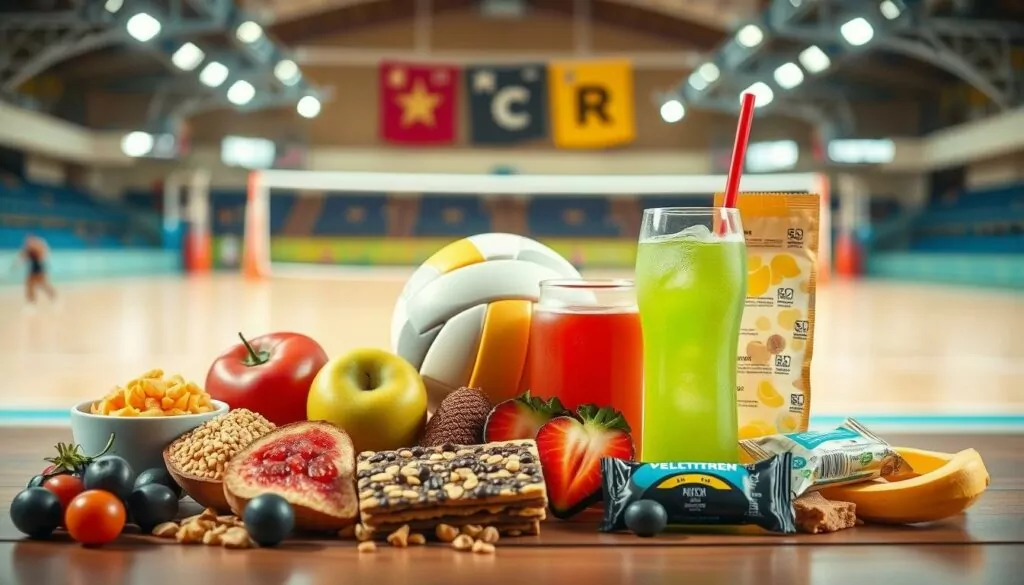Volleyball players spend 30% of a match running and jumping. This highlights the need for effective recovery strategies for female athletes. Proper recovery techniques are crucial for peak performance and injury prevention.
Volleyball challenges female athletes with explosive power, agility, and endurance demands. Players must develop vertical jumps, quick lateral moves, and cardiovascular fitness. Female volleyball players have specific recovery needs due to their height and body composition.
Proper volleyball fatigue management is key for optimal performance. A comprehensive recovery approach helps athletes adapt to training stress. It also reduces injury risk and maintains consistent performance levels.
This guide covers passive and active recovery techniques for volleyball. We’ll explore nutrition strategies and mental recovery methods. You’ll learn to balance training stress with proper recovery.
We’ll discuss how to optimize sleep for better performance. The guide also covers tailoring recovery protocols for female volleyball players’ unique needs.
Key Takeaways
- Volleyball requires a blend of explosive power, agility, and endurance
- Female athletes need tailored recovery strategies
- Balancing training stress and recovery is crucial for performance
- Proper nutrition and hydration play vital roles in recovery
- Sleep optimization is essential for enhanced recovery
- Mental recovery strategies are as important as physical ones
- A comprehensive approach to recovery can prevent injuries and improve performance
Understanding Fatigue in Female Volleyball Players
Volleyball fatigue management is vital for elite female athletes. Matches can last hours with few rest days during training. Grasping fatigue is key to optimizing volleyball performance.
Types of Fatigue in Volleyball
Female volleyball players face various fatigue types. Physical fatigue comes from muscle damage and intense exertion. Mental fatigue impacts cognitive abilities on and off court.
Neuromuscular fatigue affects coordination and movement speed in volleyball. It’s crucial to recognize these different fatigue forms.
Impact of Fatigue on Performance
Fatigue greatly affects volleyball performance. It decreases technical coordination and movement speed. It also increases the perceived effort of players.
A U19 player study showed significant drops in jump height and sprint speed after training. This highlights fatigue’s impact on key performance indicators.
The Role of Fatigue in Adaptation
Fatigue, while hindering performance, is crucial for adaptation. Elite athlete training uses the supercompensation model. It involves appropriate stress followed by recovery periods.
This process helps athletes surpass previous thresholds. It leads to improvements in strength and endurance over time.
Balancing fatigue and recovery enhances adaptation and reduces injury risks. Proper recovery allows faster muscle repair and energy replenishment. Athletes should avoid intense training for 48 hours post-competition.
| Recovery Type | Duration | Benefits |
|---|---|---|
| Physical | 48+ hours | Muscle repair, energy restoration |
| Mental | Varies | Cognitive recharge, stress reduction |
| Neuromuscular | 24-72 hours | Improved coordination, reduced fatigue |
The Importance of Recovery in Volleyball Training

Recovery is vital in volleyball training. It helps players adapt to stress and reduce fatigue. Effective strategies are key for peak performance and injury prevention.
Balancing Training Stress and Recovery
Balancing volleyball training stress and recovery is crucial. Monitoring loads and responses helps reduce injury and illness risks.
The session rating method assesses daily internal training load. External load is measured through jump height, count, and kinetic energy.
Short-term vs. Long-term Recovery Strategies
Short-term recovery focuses on post-training or post-match techniques. These include stretching, foam rolling, and proper nutrition.
Long-term strategies involve consistent sleep, balanced nutrition, and periodized training plans.
| Short-term Recovery | Long-term Recovery |
|---|---|
| Stretching | Consistent sleep patterns |
| Foam rolling | Balanced nutrition |
| Post-match nutrition | Periodized training plans |
Recovery During Training vs. Competition Periods
Recovery strategies differ between training and competition periods. Training focuses on adaptation and improvement. Competition prioritizes maintaining peak performance.
The Hooper Index measures daily wellness, fatigue, stress, muscle soreness, mood, and sleep quality.
Effective recovery is crucial for volleyball players’ best performance. Balancing training stress with proper recovery optimizes performance and reduces injury risk.
Passive Recovery Techniques for Female Volleyball Athletes

Passive recovery methods are vital for volleyball players’ well-being. These techniques focus on rest and rejuvenation. They allow your body to heal without active participation.
Sleep is crucial for passive recovery. Aim for 6-8 hours nightly, with extra rest around competitions. Quality sleep repairs muscles and restores energy levels.
Nutrition is key to passive recovery. Proper calorie and carb intake can reduce fatigue. Eat a balanced diet to support your body’s recovery processes.
“Passive recovery techniques are essential for long-term athlete well-being and performance optimization.”
Hydration is critical for volleyball recovery. Drink water throughout the day, not just during practice. Proper fluid intake maintains muscle function and prevents fatigue.
Stress management is vital for female athlete wellness. Try relaxation techniques like deep breathing or meditation. These practices can lower cortisol levels and promote recovery.
Using these passive recovery methods helps your body bounce back. You’ll be stronger after intense volleyball training or competition.
Active Recovery Methods for Optimal Performance

Active recovery volleyball techniques boost athlete performance and prevent burnout. These methods involve low-intensity exercises that clear muscle byproducts and increase blood flow. Let’s explore effective active recovery volleyball strategies to enhance your game.
Low-Intensity Exercise Protocols
Low-intensity exercises can aid volleyball muscle recovery. Activities like stationary biking, walking, yoga, and swimming improve circulation. They also maintain range of motion and reduce muscle stiffness.
These exercises help you stay fit while promoting recovery between intense training sessions.
Compression Garments and Their Benefits
Compression garments are popular among volleyball players for their recovery benefits. Studies show they can reduce muscle soreness and fatigue. Normatec recovery boots decreased delayed onset muscle soreness by 20% after eccentric exercise.
Massage and Self-Myofascial Release Techniques
Soft tissue massage and foam rolling are effective athlete recovery techniques. Massage helps reduce muscle soreness by decreasing inflammation and releasing tension. Foam rolling aids in restoring flexibility and improving range of motion.
These methods can be crucial for maintaining peak performance throughout the volleyball season.
| Recovery Method | Benefits | Effectiveness |
|---|---|---|
| Compression Garments | Reduces muscle soreness and fatigue | 20-25% reduction in DOMS |
| Soft Tissue Massage | Decreases inflammation, improves circulation | Significant reduction in muscle tension |
| Foam Rolling | Restores flexibility, improves range of motion | Effective in reducing muscle stiffness |
| Active Recovery Exercises | Enhances circulation, maintains flexibility | Improves overall muscle recovery |
Nutrition and Hydration Strategies for Volleyball Recovery

Sports nutrition is vital for female volleyball athletes. The U.S. Women’s National Team prioritizes this, even bringing their own ingredients to tournaments. Let’s explore key strategies for fueling performance and recovery.
Macronutrient Balance for Recovery
Female athletes need a careful balance of macronutrients. Women burn more fats and fewer carbs than men during exercise. Adjust your intake to match these needs.
- Carbohydrates: Replenish energy stores
- Proteins: Aid muscle repair
- Fats: Support hormone production
Hydration Protocols for Female Athletes
Proper hydration is crucial for female athletes. Women have specific thermoregulation and hydration requirements. Create a custom hydration plan based on your sweat rate and electrolyte needs.
Start hydrating before you play and continue after the game ends. This ensures your body stays well-hydrated throughout your activities.
Timing of Nutrient Intake for Optimal Recovery
Timing is key in volleyball recovery. The U.S. Women’s National Team enjoys pre-match snacks like Chocolate Peanut Butter Energy Balls. You can make these in batches and store them for up to five days.
After matches, refuel within 30 minutes to jumpstart recovery. This quick action helps your body bounce back faster.
“Nutrition isn’t just about what you eat, but when you eat it. Timing your meals around your training and matches can significantly boost your performance and recovery.”
By applying these nutrition and hydration strategies, you’ll enhance your performance and recover faster in volleyball. Your body will thank you for the extra care and attention.
Mental Recovery Strategies for Volleyball Players
Mental recovery is vital for volleyball success. The USA Women’s National Volleyball Team excels by focusing on mental skills. They use visualization, goal-setting, and mindfulness training volleyball practices.
Athlete stress management is key to peak performance. The Brazil Women’s National Volleyball Team showed incredible mental strength at the 2012 Olympics. They overcame a two-set deficit to win gold against the United States.
Volleyball performance monitoring should include mental recovery strategies. Meditation can reduce stress and improve sleep. Breathwork helps decrease anxiety and boost emotional control.
The YAX Online platform offers over 200 videos on recovery methods. These include yoga, breathwork, and meditation techniques.
“Mental toughness is not about being mean or aggressive. It’s about staying focused and composed under pressure.” – Kim Yeon-koung, South Korean volleyball superstar
Top Italian teams excel by combining physical and mental training. Igor Gorgonzola Novara and Prosecco Doc-Imoco Conegliano are prime examples. Their success highlights the importance of stress management in training routines.
| Recovery Method | Benefits |
|---|---|
| Yoga for Athletes | Muscle recovery, increased flexibility, improved balance, body awareness |
| Meditation | Stress reduction, self-confidence boost, better sleep, increased focus |
| Breathwork | Decreased stress and anxiety, improved emotional control |
Using these mental recovery strategies can boost your volleyball performance. Adjust your methods based on the athletic season for best results.
Sleep Optimization for Enhanced Recovery in Volleyball
Quality sleep is vital for volleyball performance and recovery. It significantly affects injury risk among female athletes. Better sleep quality reduced in-season injury risk by 51% for NCAA Division I players.
Longer sleep duration decreased injury risk by 31%. These findings highlight the importance of prioritizing sleep for volleyball players.
- Maintaining consistent sleep schedules
- Creating a relaxing bedtime routine
- Optimizing sleep environment (dark, quiet, cool)
- Limiting screen time before bed
Volleyball players face unique sleep challenges due to evening matches and multi-day tournaments. Coaches should encourage extended sleep after competitions. Sleep patterns can be disrupted for up to two days after events.
This disruption affects performance and increases injury risk. Players need extra rest to recover fully.
Chronotype impacts volleyball performance. Evening types may struggle with early practices. Morning types often excel in these situations.
Understanding your chronotype helps optimize training schedules and recovery strategies. This knowledge can lead to better performance.
“Good sleep quality leads to fewer disturbances before matches, improving overall performance and reducing injury risk.”
Prioritizing sleep enhances recovery and reduces injury risk for volleyball players. It also optimizes on-court performance. Good sleep hygiene is crucial for long-term success in volleyball.
Conclusion
Volleyball recovery is vital for female athletes’ performance and injury prevention. It should address both physical and mental aspects. Effective strategies can optimize your on-court performance.
Female athletes face unique challenges in volleyball. Women excel in flexibility and balance but may need to focus on core strength. Energy availability is crucial, with many athletes struggling in this area.
Shoulder injuries are common in volleyball, often linked to spiking maneuvers. Proper recovery techniques can help prevent these issues.
Nutrition is key for female athletes’ recovery. Aim for 1.6 to 2.2 g of protein per kg of body weight daily. Consume 6-10 g of carbohydrates per kg daily for optimal muscle glycogen storage.
Don’t overlook micronutrients like iron, calcium, and vitamin D. Proper hydration is essential for maximizing your on-court performance.
Tailor these techniques to your individual needs. This approach can enhance your athletic performance and extend your volleyball career. Remember, recovery is as crucial as training in achieving your goals.
